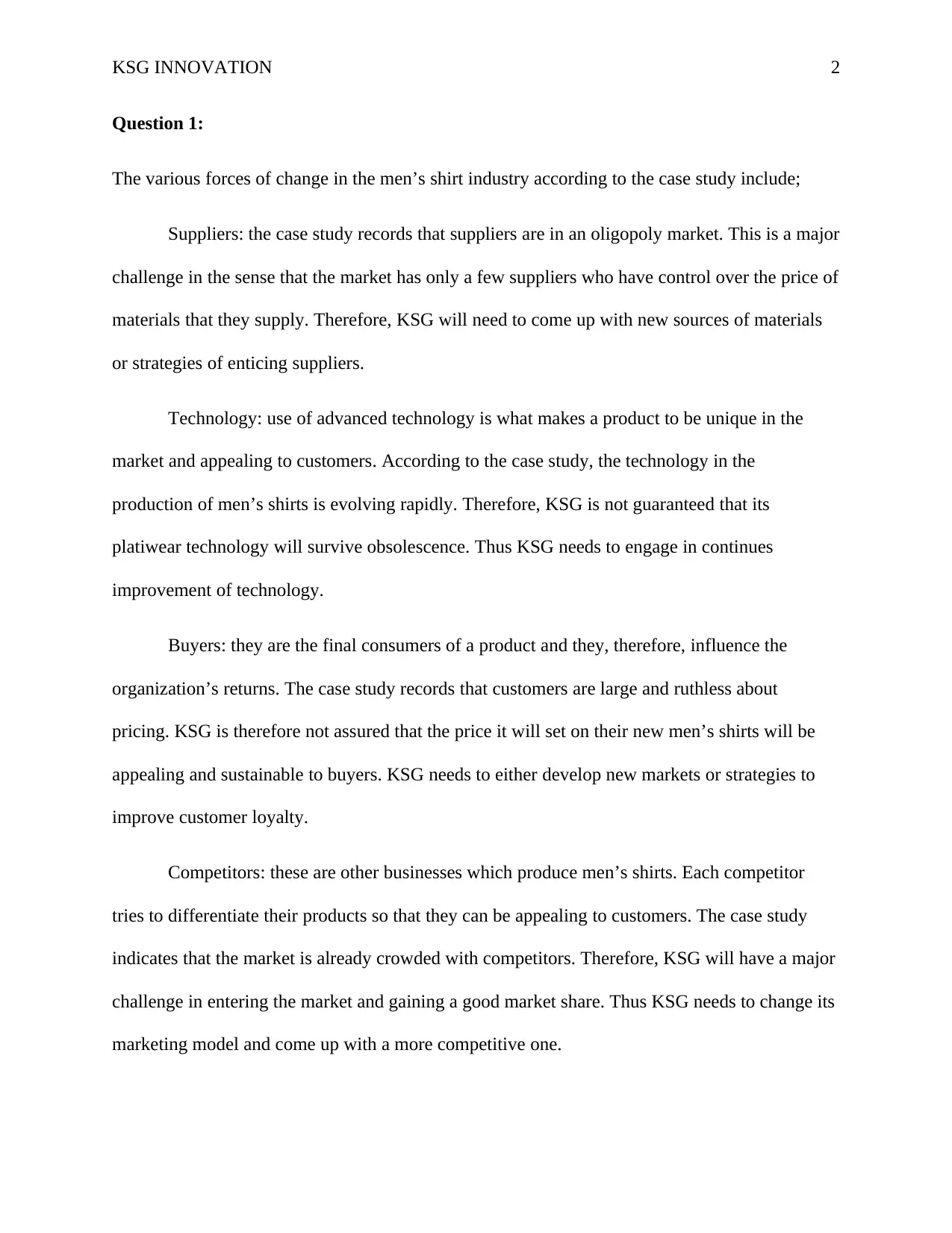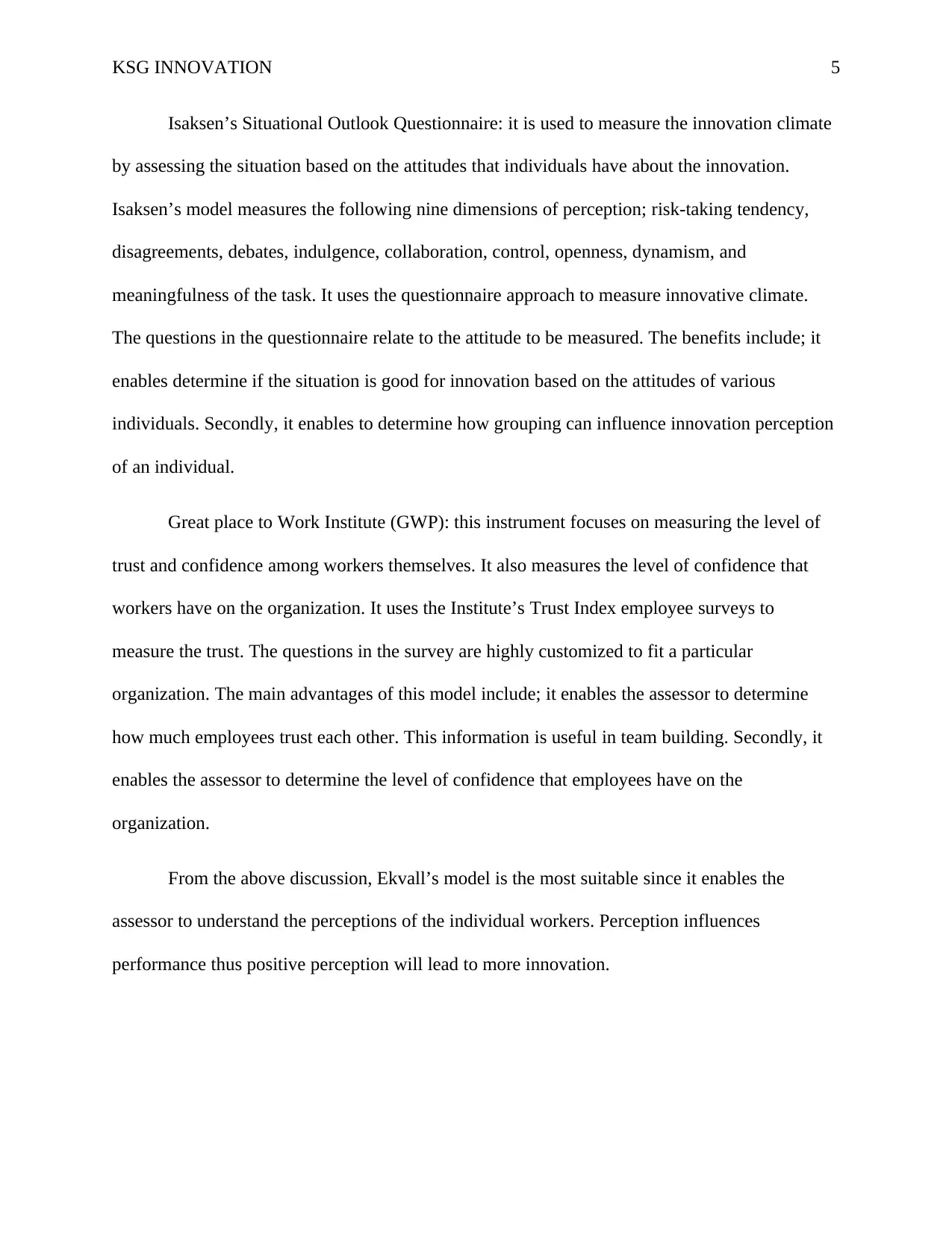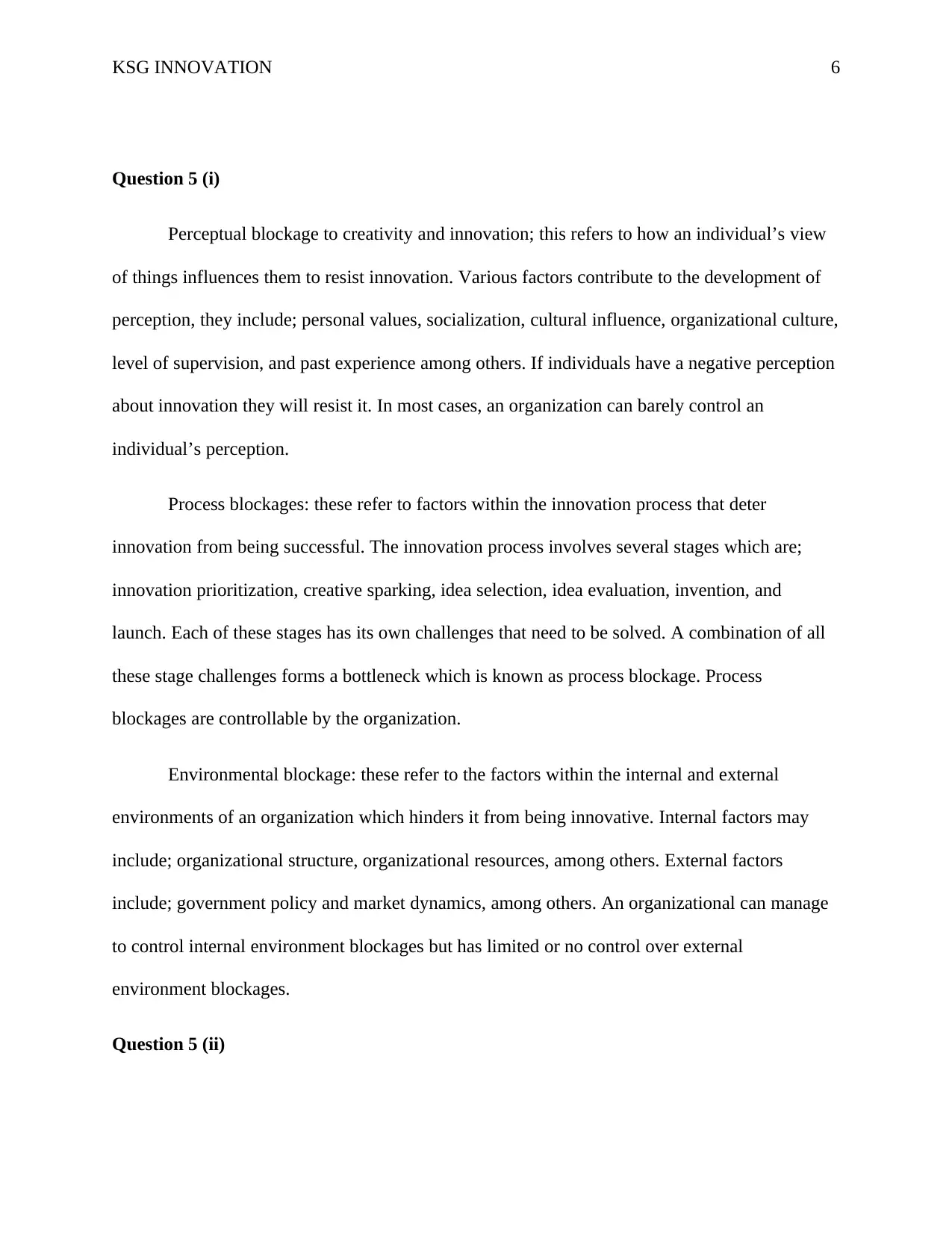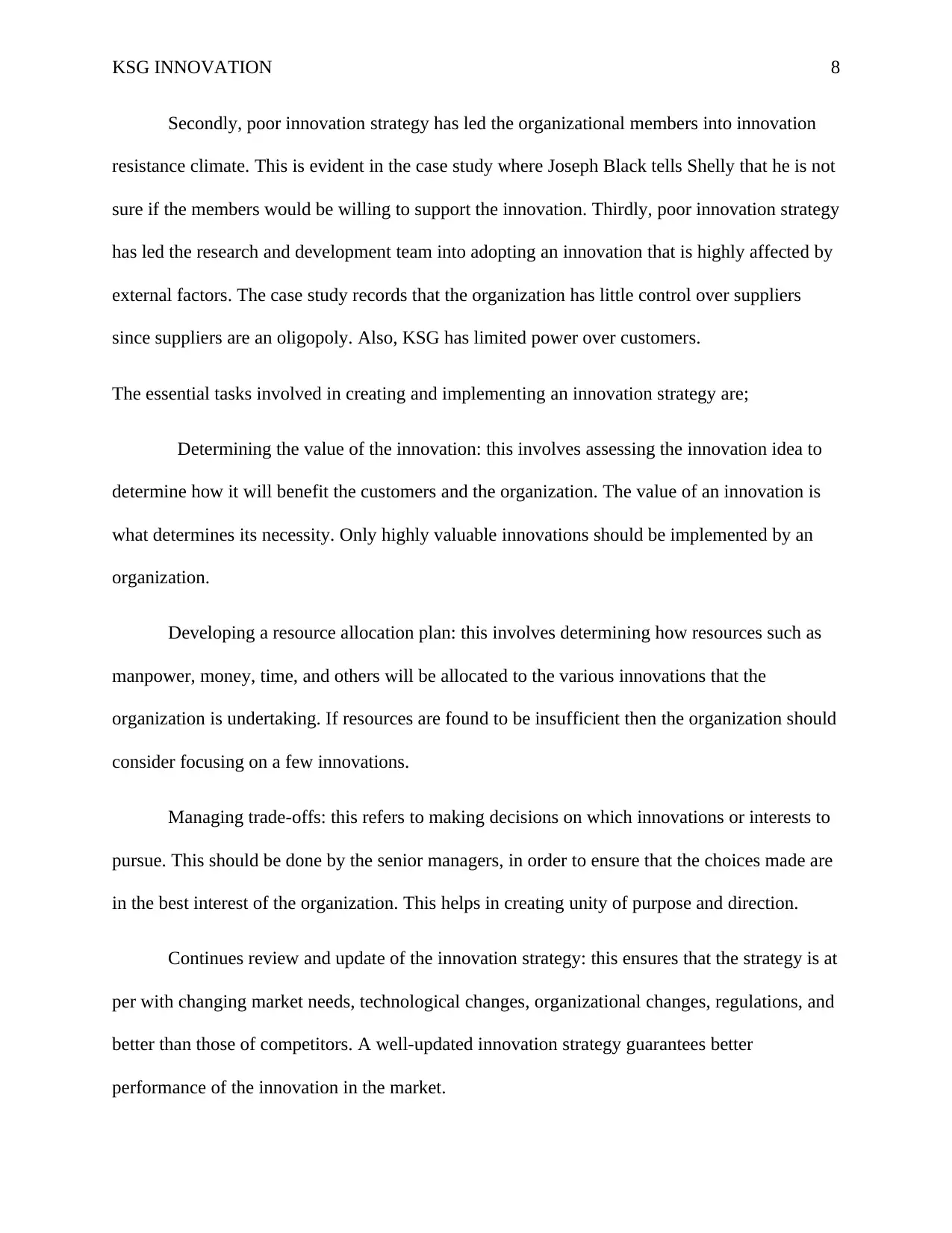BUS705: Innovation Management and Decision Making: KSG Case Study
VerifiedAdded on 2022/12/05
|9
|2085
|107
Case Study
AI Summary
This case study analyzes the innovation management and decision-making processes at KSG, a plastics and packaging company, focusing on the potential of a new plastiwear material for men's shirts. The study examines the forces of change within the men's shirt industry, including suppliers, technology, buyers, and competitors, and categorizes the type of innovation as radical, disruptive, or incremental. It identifies Jerry Tucker as a potential innovation champion and explores methods to measure the innovation climate using Ekvall’s creative climate questionnaire, Isaksen’s Situational Outlook Questionnaire, and the Great Place to Work Institute. The analysis also addresses perceptual and environmental blockages to creativity within KSG, highlighting Craig Adams's pessimism and external challenges like pricing and supplier dynamics. The case study emphasizes the importance of a well-defined innovation strategy, including value determination, resource allocation, and continuous review, to avoid uncontrolled innovation and resistance within the organization. The lack of a good strategy has led to uncontrolled innovation which can lead to failure. The paper concludes by outlining essential tasks for creating and implementing a successful innovation strategy.

Running Head: KSG INNOVATION 1
Innovation Management and Decision Making: A Case Study of KSG
By
University Affiliation
Date
Innovation Management and Decision Making: A Case Study of KSG
By
University Affiliation
Date
Paraphrase This Document
Need a fresh take? Get an instant paraphrase of this document with our AI Paraphraser

KSG INNOVATION 2
Question 1:
The various forces of change in the men’s shirt industry according to the case study include;
Suppliers: the case study records that suppliers are in an oligopoly market. This is a major
challenge in the sense that the market has only a few suppliers who have control over the price of
materials that they supply. Therefore, KSG will need to come up with new sources of materials
or strategies of enticing suppliers.
Technology: use of advanced technology is what makes a product to be unique in the
market and appealing to customers. According to the case study, the technology in the
production of men’s shirts is evolving rapidly. Therefore, KSG is not guaranteed that its
platiwear technology will survive obsolescence. Thus KSG needs to engage in continues
improvement of technology.
Buyers: they are the final consumers of a product and they, therefore, influence the
organization’s returns. The case study records that customers are large and ruthless about
pricing. KSG is therefore not assured that the price it will set on their new men’s shirts will be
appealing and sustainable to buyers. KSG needs to either develop new markets or strategies to
improve customer loyalty.
Competitors: these are other businesses which produce men’s shirts. Each competitor
tries to differentiate their products so that they can be appealing to customers. The case study
indicates that the market is already crowded with competitors. Therefore, KSG will have a major
challenge in entering the market and gaining a good market share. Thus KSG needs to change its
marketing model and come up with a more competitive one.
Question 1:
The various forces of change in the men’s shirt industry according to the case study include;
Suppliers: the case study records that suppliers are in an oligopoly market. This is a major
challenge in the sense that the market has only a few suppliers who have control over the price of
materials that they supply. Therefore, KSG will need to come up with new sources of materials
or strategies of enticing suppliers.
Technology: use of advanced technology is what makes a product to be unique in the
market and appealing to customers. According to the case study, the technology in the
production of men’s shirts is evolving rapidly. Therefore, KSG is not guaranteed that its
platiwear technology will survive obsolescence. Thus KSG needs to engage in continues
improvement of technology.
Buyers: they are the final consumers of a product and they, therefore, influence the
organization’s returns. The case study records that customers are large and ruthless about
pricing. KSG is therefore not assured that the price it will set on their new men’s shirts will be
appealing and sustainable to buyers. KSG needs to either develop new markets or strategies to
improve customer loyalty.
Competitors: these are other businesses which produce men’s shirts. Each competitor
tries to differentiate their products so that they can be appealing to customers. The case study
indicates that the market is already crowded with competitors. Therefore, KSG will have a major
challenge in entering the market and gaining a good market share. Thus KSG needs to change its
marketing model and come up with a more competitive one.

KSG INNOVATION 3
Question 2:
Incremental innovation: this refers to making a series of upgrades or small improvements
on an existing product. Incremental innovation is used to increase the utility of a product or a
service to customers. This type of innovation increases the market penetration of a product or
service over a period of time.
Radical innovation: it a type of invention that destroys the existing technology and
replaces it with completely new technology. Radical innovation is mainly used where there is a
need to change the existing product or when there is no existing product at all. KSG Platiwear
men’s shirt is a radical invention.
Disruptive innovation: it is also known as stealth innovation. It is an innovation that
significantly affects the way a market performs through improving on what is already existing in
the market. The technology innovation gets into the market stealthily and after it fully evolves, it
starts disrupting existing products, services or technologies.
Greenplastic can be classified as a disruptive innovation. This can be justified by the fact
that the case study records that Greenplastic is providing a solution to an existing market.
Secondly, the case study records that orders have already been placed by customers thus
proofing stealth growth and disruption of the market.
Question 3
Innovation champions are people within an organization who are passionate about
playing an active role to make innovation thrive within the organization. The characteristics of
innovation champions include; they have confidence in what they do and they believe that the
innovation can succeed. Secondly, they are ready and willing to take risks to bring up an
Question 2:
Incremental innovation: this refers to making a series of upgrades or small improvements
on an existing product. Incremental innovation is used to increase the utility of a product or a
service to customers. This type of innovation increases the market penetration of a product or
service over a period of time.
Radical innovation: it a type of invention that destroys the existing technology and
replaces it with completely new technology. Radical innovation is mainly used where there is a
need to change the existing product or when there is no existing product at all. KSG Platiwear
men’s shirt is a radical invention.
Disruptive innovation: it is also known as stealth innovation. It is an innovation that
significantly affects the way a market performs through improving on what is already existing in
the market. The technology innovation gets into the market stealthily and after it fully evolves, it
starts disrupting existing products, services or technologies.
Greenplastic can be classified as a disruptive innovation. This can be justified by the fact
that the case study records that Greenplastic is providing a solution to an existing market.
Secondly, the case study records that orders have already been placed by customers thus
proofing stealth growth and disruption of the market.
Question 3
Innovation champions are people within an organization who are passionate about
playing an active role to make innovation thrive within the organization. The characteristics of
innovation champions include; they have confidence in what they do and they believe that the
innovation can succeed. Secondly, they are ready and willing to take risks to bring up an
⊘ This is a preview!⊘
Do you want full access?
Subscribe today to unlock all pages.

Trusted by 1+ million students worldwide

KSG INNOVATION 4
innovation. Thirdly, they have a lot of commitment to innovation in order to ensure that it
succeeds. Fourth, they clearly understand the innovation and the value that it brings. This
involves relating an existing marketing gap or problem to a solution that the innovation will
provide.
Innovation champions have several roles in an organization which includes;
commercializing the innovation so that it can generate value to the organization. Secondly,
coming up with creative ideas about new innovations and implementing them. Thirdly,
influencing other people within the organization on the need to embrace and support the
innovation. Fourth, performing continues incremental innovation to ensure that the initial
innovation remains competitive in the market and prevent it from obsolescence. In KSG, based
on the case study, Jerry Tucker the senior research and development scientist would perfectly fit
this role due to his creativity and passion for innovation.
Question 4
There are three instruments that shelly can use to measure the innovation climate in KSG.
Ekvall’s (1990) creative climate questionnaire: it measures organizational innovative
climate based on individual perceptions. It does so by measuring ten dimensions which are based
research. The ten factors are; challenge, freedom, idea support, trust/ openness, flexibility,
playfulness, deliberations, conflicts, risk-taking propensity, and idea lead time. The approach to
be used is a questionnaire consisting of properly crafted and logically organized questions. The
benefits of the instrument include; it enables one to identify the perceptions that people have
about the innovation. Secondly, it helps in determining the intensity of such perception in order
to determine if they can be influenced or changed.
innovation. Thirdly, they have a lot of commitment to innovation in order to ensure that it
succeeds. Fourth, they clearly understand the innovation and the value that it brings. This
involves relating an existing marketing gap or problem to a solution that the innovation will
provide.
Innovation champions have several roles in an organization which includes;
commercializing the innovation so that it can generate value to the organization. Secondly,
coming up with creative ideas about new innovations and implementing them. Thirdly,
influencing other people within the organization on the need to embrace and support the
innovation. Fourth, performing continues incremental innovation to ensure that the initial
innovation remains competitive in the market and prevent it from obsolescence. In KSG, based
on the case study, Jerry Tucker the senior research and development scientist would perfectly fit
this role due to his creativity and passion for innovation.
Question 4
There are three instruments that shelly can use to measure the innovation climate in KSG.
Ekvall’s (1990) creative climate questionnaire: it measures organizational innovative
climate based on individual perceptions. It does so by measuring ten dimensions which are based
research. The ten factors are; challenge, freedom, idea support, trust/ openness, flexibility,
playfulness, deliberations, conflicts, risk-taking propensity, and idea lead time. The approach to
be used is a questionnaire consisting of properly crafted and logically organized questions. The
benefits of the instrument include; it enables one to identify the perceptions that people have
about the innovation. Secondly, it helps in determining the intensity of such perception in order
to determine if they can be influenced or changed.
Paraphrase This Document
Need a fresh take? Get an instant paraphrase of this document with our AI Paraphraser

KSG INNOVATION 5
Isaksen’s Situational Outlook Questionnaire: it is used to measure the innovation climate
by assessing the situation based on the attitudes that individuals have about the innovation.
Isaksen’s model measures the following nine dimensions of perception; risk-taking tendency,
disagreements, debates, indulgence, collaboration, control, openness, dynamism, and
meaningfulness of the task. It uses the questionnaire approach to measure innovative climate.
The questions in the questionnaire relate to the attitude to be measured. The benefits include; it
enables determine if the situation is good for innovation based on the attitudes of various
individuals. Secondly, it enables to determine how grouping can influence innovation perception
of an individual.
Great place to Work Institute (GWP): this instrument focuses on measuring the level of
trust and confidence among workers themselves. It also measures the level of confidence that
workers have on the organization. It uses the Institute’s Trust Index employee surveys to
measure the trust. The questions in the survey are highly customized to fit a particular
organization. The main advantages of this model include; it enables the assessor to determine
how much employees trust each other. This information is useful in team building. Secondly, it
enables the assessor to determine the level of confidence that employees have on the
organization.
From the above discussion, Ekvall’s model is the most suitable since it enables the
assessor to understand the perceptions of the individual workers. Perception influences
performance thus positive perception will lead to more innovation.
Isaksen’s Situational Outlook Questionnaire: it is used to measure the innovation climate
by assessing the situation based on the attitudes that individuals have about the innovation.
Isaksen’s model measures the following nine dimensions of perception; risk-taking tendency,
disagreements, debates, indulgence, collaboration, control, openness, dynamism, and
meaningfulness of the task. It uses the questionnaire approach to measure innovative climate.
The questions in the questionnaire relate to the attitude to be measured. The benefits include; it
enables determine if the situation is good for innovation based on the attitudes of various
individuals. Secondly, it enables to determine how grouping can influence innovation perception
of an individual.
Great place to Work Institute (GWP): this instrument focuses on measuring the level of
trust and confidence among workers themselves. It also measures the level of confidence that
workers have on the organization. It uses the Institute’s Trust Index employee surveys to
measure the trust. The questions in the survey are highly customized to fit a particular
organization. The main advantages of this model include; it enables the assessor to determine
how much employees trust each other. This information is useful in team building. Secondly, it
enables the assessor to determine the level of confidence that employees have on the
organization.
From the above discussion, Ekvall’s model is the most suitable since it enables the
assessor to understand the perceptions of the individual workers. Perception influences
performance thus positive perception will lead to more innovation.

KSG INNOVATION 6
Question 5 (i)
Perceptual blockage to creativity and innovation; this refers to how an individual’s view
of things influences them to resist innovation. Various factors contribute to the development of
perception, they include; personal values, socialization, cultural influence, organizational culture,
level of supervision, and past experience among others. If individuals have a negative perception
about innovation they will resist it. In most cases, an organization can barely control an
individual’s perception.
Process blockages: these refer to factors within the innovation process that deter
innovation from being successful. The innovation process involves several stages which are;
innovation prioritization, creative sparking, idea selection, idea evaluation, invention, and
launch. Each of these stages has its own challenges that need to be solved. A combination of all
these stage challenges forms a bottleneck which is known as process blockage. Process
blockages are controllable by the organization.
Environmental blockage: these refer to the factors within the internal and external
environments of an organization which hinders it from being innovative. Internal factors may
include; organizational structure, organizational resources, among others. External factors
include; government policy and market dynamics, among others. An organizational can manage
to control internal environment blockages but has limited or no control over external
environment blockages.
Question 5 (ii)
Question 5 (i)
Perceptual blockage to creativity and innovation; this refers to how an individual’s view
of things influences them to resist innovation. Various factors contribute to the development of
perception, they include; personal values, socialization, cultural influence, organizational culture,
level of supervision, and past experience among others. If individuals have a negative perception
about innovation they will resist it. In most cases, an organization can barely control an
individual’s perception.
Process blockages: these refer to factors within the innovation process that deter
innovation from being successful. The innovation process involves several stages which are;
innovation prioritization, creative sparking, idea selection, idea evaluation, invention, and
launch. Each of these stages has its own challenges that need to be solved. A combination of all
these stage challenges forms a bottleneck which is known as process blockage. Process
blockages are controllable by the organization.
Environmental blockage: these refer to the factors within the internal and external
environments of an organization which hinders it from being innovative. Internal factors may
include; organizational structure, organizational resources, among others. External factors
include; government policy and market dynamics, among others. An organizational can manage
to control internal environment blockages but has limited or no control over external
environment blockages.
Question 5 (ii)
⊘ This is a preview!⊘
Do you want full access?
Subscribe today to unlock all pages.

Trusted by 1+ million students worldwide

KSG INNOVATION 7
Perceptual blockage is evident in KSG. This can be justified by the fact that Craig
Adams the vice president of the oil and gas division is very pessimistic about the performance of
plastiwear in the market. For example; according to the case study Craig Adams tells Shelly that
it will be difficult for KSG to venture into shirt making because the company has no past
experience in shirt making. Also, Craig gives justifications such as high competition, and
technological change to convince Shelly that the plastiwear innovation is not appropriate. This
negative perception that Craig has about plastiwear is a perception blockage to innovation in
KSG.
Environmental blockage is also present KSG. This blockage is mainly in the external
environment. The case study records that customers are so ruthless on pricing. This makes it
difficult for KSG to predict its break-even- point and the returns it expects from the project since
the customers make the prices to be unstable. Thus blocking the innovation. Secondly, the case
study records that the suppliers are an oligopoly. Therefore, KSG has no control over material
supplied to it and thus it cannot be able to develop a reliable production and distribution model.
This is a major blockage to the innovation.
Question 6
An innovation strategy is a plan to increase market share or returns through product or
service innovation. At KSG lack of a good innovation strategy has led the organization into
uncontrolled innovation which can lead to failure. KSG has already innovated plastiwear shirts
even before the Greenplastic innovation has gained sufficient strength or market share. If KSG
adopts the new plasiwear innovation it will be in a crisis to nurse two young innovations.
Perceptual blockage is evident in KSG. This can be justified by the fact that Craig
Adams the vice president of the oil and gas division is very pessimistic about the performance of
plastiwear in the market. For example; according to the case study Craig Adams tells Shelly that
it will be difficult for KSG to venture into shirt making because the company has no past
experience in shirt making. Also, Craig gives justifications such as high competition, and
technological change to convince Shelly that the plastiwear innovation is not appropriate. This
negative perception that Craig has about plastiwear is a perception blockage to innovation in
KSG.
Environmental blockage is also present KSG. This blockage is mainly in the external
environment. The case study records that customers are so ruthless on pricing. This makes it
difficult for KSG to predict its break-even- point and the returns it expects from the project since
the customers make the prices to be unstable. Thus blocking the innovation. Secondly, the case
study records that the suppliers are an oligopoly. Therefore, KSG has no control over material
supplied to it and thus it cannot be able to develop a reliable production and distribution model.
This is a major blockage to the innovation.
Question 6
An innovation strategy is a plan to increase market share or returns through product or
service innovation. At KSG lack of a good innovation strategy has led the organization into
uncontrolled innovation which can lead to failure. KSG has already innovated plastiwear shirts
even before the Greenplastic innovation has gained sufficient strength or market share. If KSG
adopts the new plasiwear innovation it will be in a crisis to nurse two young innovations.
Paraphrase This Document
Need a fresh take? Get an instant paraphrase of this document with our AI Paraphraser

KSG INNOVATION 8
Secondly, poor innovation strategy has led the organizational members into innovation
resistance climate. This is evident in the case study where Joseph Black tells Shelly that he is not
sure if the members would be willing to support the innovation. Thirdly, poor innovation strategy
has led the research and development team into adopting an innovation that is highly affected by
external factors. The case study records that the organization has little control over suppliers
since suppliers are an oligopoly. Also, KSG has limited power over customers.
The essential tasks involved in creating and implementing an innovation strategy are;
Determining the value of the innovation: this involves assessing the innovation idea to
determine how it will benefit the customers and the organization. The value of an innovation is
what determines its necessity. Only highly valuable innovations should be implemented by an
organization.
Developing a resource allocation plan: this involves determining how resources such as
manpower, money, time, and others will be allocated to the various innovations that the
organization is undertaking. If resources are found to be insufficient then the organization should
consider focusing on a few innovations.
Managing trade-offs: this refers to making decisions on which innovations or interests to
pursue. This should be done by the senior managers, in order to ensure that the choices made are
in the best interest of the organization. This helps in creating unity of purpose and direction.
Continues review and update of the innovation strategy: this ensures that the strategy is at
per with changing market needs, technological changes, organizational changes, regulations, and
better than those of competitors. A well-updated innovation strategy guarantees better
performance of the innovation in the market.
Secondly, poor innovation strategy has led the organizational members into innovation
resistance climate. This is evident in the case study where Joseph Black tells Shelly that he is not
sure if the members would be willing to support the innovation. Thirdly, poor innovation strategy
has led the research and development team into adopting an innovation that is highly affected by
external factors. The case study records that the organization has little control over suppliers
since suppliers are an oligopoly. Also, KSG has limited power over customers.
The essential tasks involved in creating and implementing an innovation strategy are;
Determining the value of the innovation: this involves assessing the innovation idea to
determine how it will benefit the customers and the organization. The value of an innovation is
what determines its necessity. Only highly valuable innovations should be implemented by an
organization.
Developing a resource allocation plan: this involves determining how resources such as
manpower, money, time, and others will be allocated to the various innovations that the
organization is undertaking. If resources are found to be insufficient then the organization should
consider focusing on a few innovations.
Managing trade-offs: this refers to making decisions on which innovations or interests to
pursue. This should be done by the senior managers, in order to ensure that the choices made are
in the best interest of the organization. This helps in creating unity of purpose and direction.
Continues review and update of the innovation strategy: this ensures that the strategy is at
per with changing market needs, technological changes, organizational changes, regulations, and
better than those of competitors. A well-updated innovation strategy guarantees better
performance of the innovation in the market.

KSG INNOVATION 9
⊘ This is a preview!⊘
Do you want full access?
Subscribe today to unlock all pages.

Trusted by 1+ million students worldwide
1 out of 9
Related Documents
Your All-in-One AI-Powered Toolkit for Academic Success.
+13062052269
info@desklib.com
Available 24*7 on WhatsApp / Email
![[object Object]](/_next/static/media/star-bottom.7253800d.svg)
Unlock your academic potential
Copyright © 2020–2025 A2Z Services. All Rights Reserved. Developed and managed by ZUCOL.





